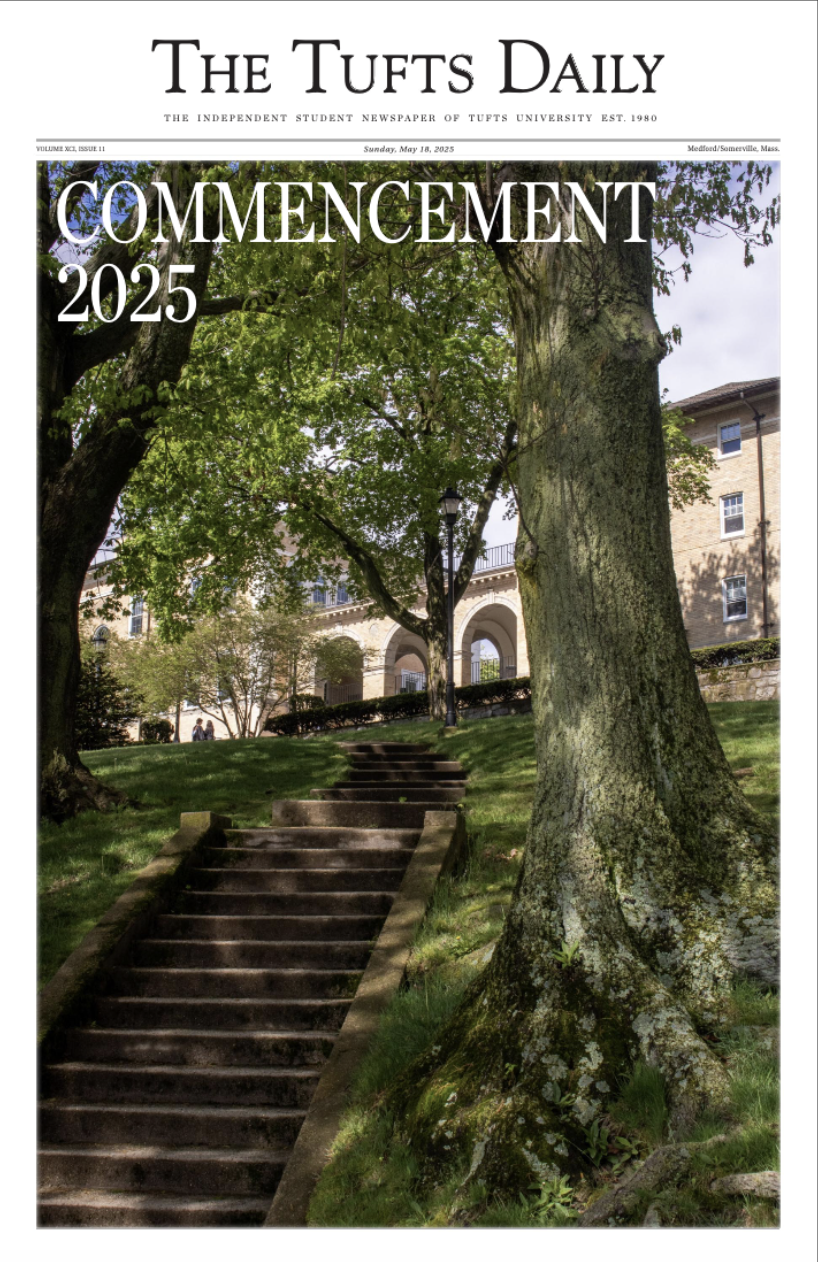A multimedia installation starring leafcutter ant patterns. Chinese Mexican identity explored through early 20th-century printmaking. These are just a couple of projects that students are pursuing as they finish the SMFA Combined Degree program, where students spend five years earning two degrees simultaneously: a Bachelor of Fine Arts from the School of the Museum of Fine Arts at Tufts University and a Bachelor of Art or Bachelor of Science from the School of Arts and Sciences.
Anneke Chan, a graduating fifth-year student studying international literary and visual studies, emphasized how rare it is to find an opportunity to pursue two different kinds of passions.
“I like to make art, and I felt invested in that. I didn’t want to feel like I was making some sort of compromise between that and pursuing a liberal arts education,” Chan said.
This breadth enables Adrian Wong, a graduating fifth-year student majoring in film and media studies, to refine different aspects of his practice.
“I think of my SMFA classes as more like conceptual sandboxes for me to exercise theory,” Wong said. “Whereas my program at Tufts, the film program, is more practical and technical.”
Sometimes, there is little to no crossover between the degrees. Graduating fifth-year Ava Sakamoto is majoring in community health while fulfilling requirements for medical school. They expressed how frustrating it is that art can be seen as a hobby to be sacrificed for other endeavors.
“I’ve always really liked art as a kid,” Sakamoto said. “People were like, ‘Ava, you’re so smart, but as you get older, you’re going to leave that all behind, right?’ … Like [they’re] saying an artist can’t be as successful as a doctor.”
For Isabella Arabia, their major in biopsychology and their SMFA studio classes go hand in hand. They are graduating this May after only four years in the Combined Degree program and will start their master’s degree in biology at Tufts this fall.
“Now I’m more interested in ecology and animal behavior, but it still feels like there’s this kind of perfection in nature and biology that I find really beautiful, and my art is a way for me to explore my interest in science in a different way,” Arabia said. “My art practice now is all about my science and my research, and that allows it to be kind of cohesive.”
To culminate their studies, combined-degree students have the option of doing a semester-long SMFA senior thesis or a yearlong senior honors thesis for their Arts and Sciences degree. This year, SMFA removed selectivity from the thesis experience, allowing any student to embark on one if they choose. Sakamoto is working on a joint SMFA senior thesis with her friend Mimi, but she acknowledges that there are some glaring challenges.
“First of all, it’s only a semester, so that already is [a] time crunch. But then the second thing is, there’s not a lot of opportunities for funding,” Sakamoto said.
Many applications for funding close before students commit to doing a thesis, leaving them to have to pay for physical material costs out of pocket. Better guidance and funding infrastructure could be a major help in reducing this financial barrier.
Many combined-degree students choose to live near the Medford/Somerville Campus, which Sakamoto attributes to the larger student population, student organizations and frequent events.
“I feel like the BFA people are more closely intertwined,” Sakamoto said. “The combined-degree people tend to gravitate toward staying closer to Medford.”
Having a foot in each world can be tricky. Arabia, who attended a conservative high school in South Florida, had initially expected to fit in more with the creative community at SMFA but ended up feeling more at home on the Medford/Somerville campus after being a resident assistant there since her sophomore year.
“I still felt like, when I came to SMFA, I didn’t fit in, but in a different way,” Arabia said. “At that point in time, it felt like you [had] to dress in a certain way to be considered a real artist, or you [had] to act a certain way, or like certain things … There’s some kind of pressure. And then at Tufts, people just don’t take your art degree seriously.”
The typical Class of 2025 combined-degree student started their college career during the height of the COVID-19 pandemic. Chan expressed gratitude for the five-year pacing of the Combined Degree program, especially considering the health restrictions that governed the beginning of her college experience. It’s during the latter half of her time at Tufts that Chan was really able to hone in on her interests in printmaking and book arts, as well as integrate her studio practice with research from her international visual and literary studies major.
“Having matriculated in fall of 2020, I feel like I’ve seen the campus go through many versions of itself,” Chan said.
For strengthening her skills, Chan shared her appreciation for having one more year in college than a typical undergraduate student.
“I really do value having the extra time in this space to understand the kind of creator and thinker and person that I want to be, and also to grow alongside new people and old people.”
However, the fifth year of the program can entail major social shifts. Unlike other undergraduates, combined-degree students watch their peers who entered college with them graduate a year before they do. Wong described how most of his Tufts friends are now alumni but how he’s lucky that some remain in the Greater Boston area and do not let distance or circumstance hinder their relationships.
“I remember, when we were all still in school together … there was this whole family aspect that I really miss nowadays because a lot of my friends aren’t in this vicinity,” Wong said. “At the same time, it’s also so validating that so many of my friends have always made the trek to come to my house. … I think it’s really sweet.”
For Wong, it can sometimes be easier to resonate with faculty than with younger students. He finds that meeting individually with professors is very accessible at Tufts, where one conversation can lead to another, and common hobbies can become the foundation of friendship.
“Me and one of the art history professors, we do radio together sometimes, and then we talk a lot about music and art. I think that’s amazing because I got to bond with him on a really casual level,” Wong said. “Another professor, who I’m studio assisting at the SMFA, we cycle together because we both have this shared obsession.”
All four of these students are heavily involved in campus life and have diverse extracurricular responsibilities. Sakamoto described many combined-degree students, including themself, as “bonkers” for pursuing demanding workloads, which can result in a lot of cumulative stress.
“Everyone is so exhausted right now,” Sakamoto said. “The pressure [of], ‘I have to leave the comfort of academia and [go] into the workforce soon,’ is getting to be very real.”
Wong echoed this sentiment, reflecting on how much his fifth year has impacted him as graduation approaches.
“I definitely feel like I’ve changed a lot. I don’t know if I’ve matured, necessarily. Maybe I’ve become more cynical about the world because I’m about to leave this safe haven, this bubble,” Wong said. “Tufts has meant a lot to me, and I feel so familiar and comfortable in this place, so I think the transition is very jarring for me.”
Regardless of where they end up next, these combined-degree students are keen to leave things better than the state they found them in. Their rigorous commitment to interdisciplinary education is bound to shape the way they move through future internships, jobs and higher degrees. Some of them are showcasing their work at the SMFA Senior Thesis Exhibition, where you can learn more about how they dovetail their identities as artists, researchers, scientists and so on.
“It’s hard to define yourself as one or the other,” Arabia said. “I hope one day, after getting a Ph.D. and maybe going into academia — who knows — I can bring the art back in because it’s really important to me and how I see the world and how I want my contribution to the world to be.”






